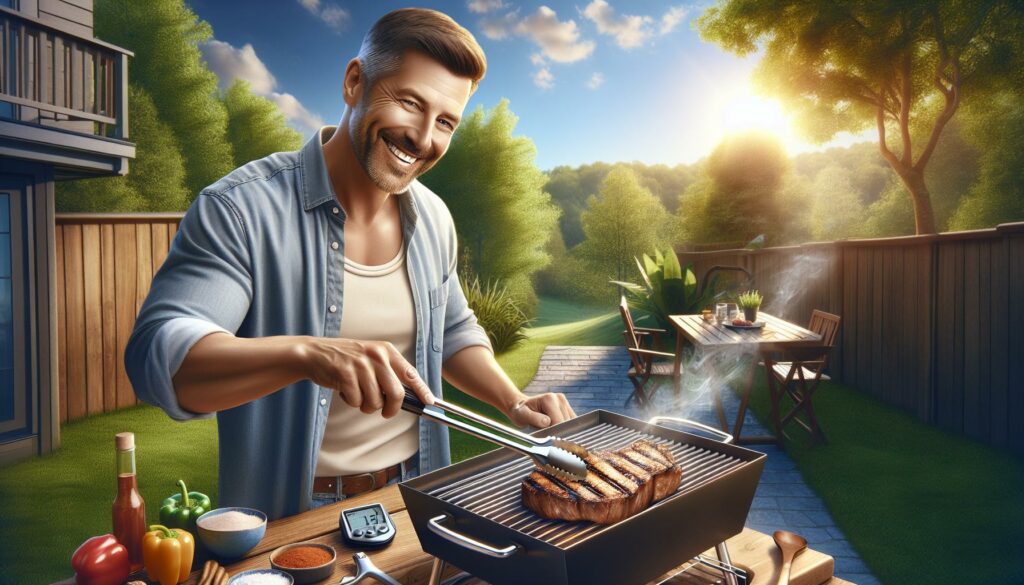Mastering the art of cooking meat can transform an ordinary meal into a mouthwatering masterpiece. From searing a perfect steak to slow-roasting a tender brisket there’s a whole world of techniques waiting to be explored. Whether you’re a kitchen novice or a seasoned chef the right cooking method can make all the difference between a tough disappointing dinner and a juicy flavorful feast.
Think of meat cooking as a delicious science experiment where temperature timing and technique dance together in perfect harmony. Each cut of meat has its own personality and demands a specific approach. That’s why understanding the basics of different cooking methods isn’t just helpful – it’s essential for anyone who wants to level up their culinary game and impress their dinner guests with restaurant-quality results.
Meat Cooking Techniques
Each type of meat comes with distinct characteristics that determine optimal cooking methods. Understanding these properties ensures proper preparation techniques for maximum flavor development.
Beef, Pork, and Poultry Characteristics
Beef contains varying levels of marbling based on the cut location with prime cuts featuring 8-13% intramuscular fat. Ribeye steaks offer rich marbling throughout while tenderloin provides lean protein with minimal fat content.
| Meat Type | Protein % | Fat % | Cooking Temp (°F) |
|---|---|---|---|
| Beef | 26-27 | 5-14 | 145-160 |
| Pork | 25-26 | 4-10 | 145-160 |
| Chicken | 31-32 | 3-7 | 165 |
Pork demonstrates muscle fiber patterns that run parallel requiring cuts across the grain. Modern pork contains 75% less fat than heritage breeds with loin cuts measuring 4% total fat content. Poultry features light meat sections containing 3% fat while dark meat sections hold 7% fat creating distinct cooking requirements.
Game Meat and Seafood Considerations
Game meats contain dense protein structures with minimal fat content requiring precise temperature control. Venison maintains 3% fat content while containing 30% protein making it susceptible to overcooking.
| Protein Type | Fat % | Moisture % | Max Cook Temp (°F) |
|---|---|---|---|
| Venison | 3 | 73 | 145 |
| Duck | 6 | 70 | 165 |
| Salmon | 13 | 68 | 145 |
Fresh seafood presents unique protein structures that denature rapidly at temperatures above 145°F. Fish contains high moisture content ranging 65-75% requiring careful monitoring during cooking. Shellfish demonstrate distinct texture changes indicating doneness with proteins firming at specific temperature points.
Essential Meat Cooking Methods
Meat cooking methods fall into distinct categories based on heat application techniques. Each method delivers unique textures flavors while maximizing the natural qualities of different meat cuts.
Dry Heat Cooking Techniques
Dry heat cooking transforms meat through direct exposure to hot air or fat without added moisture. Roasting creates a brown exterior crust at temperatures between 300°F-450°F in an oven. Broiling uses intense overhead heat exceeding 550°F to sear meat surfaces quickly. Pan-searing locks in juices by cooking meat in a hot skillet at 400°F-450°F. Grilling imparts smoky flavors through direct heat contact at 375°F-450°F. Deep-frying submerges meat in 350°F-375°F oil for a crispy exterior.
Moist Heat Cooking Techniques
Moist heat methods use liquid or steam to cook meat slowly at lower temperatures. Braising combines searing with slow cooking in liquid at 275°F-325°F for 2-4 hours. Stewing submerges small meat pieces completely in liquid at 200°F-250°F for 1-3 hours. Poaching gently cooks delicate meats in 160°F-180°F liquid without boiling. Steaming suspends meat above simmering water at 212°F preserving moisture content. These techniques break down tough connective tissues creating tender results.
Direct vs. Indirect Heat Methods
Direct heat cooking exposes meat to immediate heat sources at 400°F-500°F creating quick exterior browning. Grilling hamburgers searing steaks barbecuing chicken pieces exemplify direct methods. Indirect heat maintains consistent temperatures between 225°F-350°F by positioning meat away from heat sources. Smoking large roasts cooking whole poultry barbecuing ribs demonstrate indirect techniques. Temperature control determines cooking speed moisture retention final texture quality.
| Method Type | Temperature Range | Typical Cooking Time |
|---|---|---|
| Direct Heat | 400°F-500°F | 5-15 minutes |
| Indirect Heat | 225°F-350°F | 1-6 hours |
| Moist Heat | 160°F-325°F | 1-4 hours |
| Dry Heat | 300°F-550°F | 10-60 minutes |
Temperature and Timing Guidelines
Precise temperature control ensures food safety and optimal flavor development in meat cooking. Internal temperature measurements coupled with proper timing create consistently delicious results.
Proper Internal Temperature by Meat Type
Internal temperatures vary significantly across different meat types based on food safety standards and desired doneness.
| Meat Type | Safe Internal Temperature (°F) | Doneness Level |
|---|---|---|
| Beef/Lamb | 125-130 | Rare |
| 130-140 | Medium Rare | |
| 140-150 | Medium | |
| 160+ | Well Done | |
| Pork | 145 | Medium |
| 160 | Well Done | |
| Poultry | 165 | Safe Minimum |
| Ground Meats | 160 | Safe Minimum |
| Fish | 145 | Fully Cooked |
Resting Periods and Carryover Cooking
Carryover cooking continues after removing meat from heat, raising internal temperature by 5-10°F. Large cuts require 10-20 minutes of resting time, while smaller portions need 5-10 minutes. The resting period allows muscle fibers to reabsorb juices, ensuring moisture retention throughout the meat. Tenting meat with aluminum foil maintains warmth during resting without trapping excess steam. Proper resting produces juicier results by preventing moisture loss when cutting into the meat.
| Cut Size | Resting Time (minutes) | Temperature Rise (°F) |
|---|---|---|
| Small (steaks/chops) | 5-10 | 5-7 |
| Medium (roasts) | 10-15 | 7-10 |
| Large (whole birds) | 15-20 | 8-12 |
Tools and Equipment for Cooking Meat
Professional-grade tools enhance meat cooking precision, quality and safety. The right equipment transforms raw ingredients into perfectly cooked dishes through temperature control and proper handling.
Kitchen Essentials and Thermometers
A digital instant-read thermometer provides accurate internal temperature readings within 2-3 seconds. Heavy-bottomed stainless steel or cast iron pans distribute heat evenly across cooking surfaces. Additional essential tools include:
- Sturdy tongs with silicone tips for secure meat handling
- Sharp knives (chef’s knife, boning knife, slicing knife) for proper cutting
- Cutting boards with juice grooves to catch meat drippings
- Meat mallets for tenderizing tough cuts
- Roasting pans with racks for elevated cooking
- Kitchen twine for trussing poultry or tying roasts
Temperature monitoring tools include: - Probe thermometers for continuous temperature tracking
- Infrared thermometers for surface temperature readings
- Bluetooth-enabled smart thermometers for remote monitoring
Grilling and Smoking Equipment
Outdoor cooking equipment varies based on heat source and cooking method. Essential grilling tools include:
- Gas or charcoal grills with temperature gauges
- Chimney starters for lighting charcoal efficiently
- Long-handled spatulas and tongs for safe handling
- Grill brushes for cleaning cooking grates
- Heat-resistant gloves rated for 500°F+ temperatures
Smoking equipment features:
- Digital smokers with temperature controls
- Wood chip boxes for flavor enhancement
- Water pans for moisture retention
- Smoke boxes for cold smoking
- Drip pans for collecting rendered fat
These tools maximize cooking control and ensure consistent results across different meat preparation methods.
Common Meat Cooking Mistakes to Avoid
Mastering meat cooking techniques requires avoiding critical errors that compromise flavor, texture and food safety. Understanding these common pitfalls helps create consistently excellent results.
Temperature Control Issues
Incorrect temperature management leads to undercooked or overcooked meat. Using inaccurate thermometers results in unsafe internal temperatures below 145°F for whole cuts and 165°F for ground meats. Cooking at excessively high temperatures creates a burned exterior with raw centers, while low temperatures produce gray, rubbery textures. Opening the oven door frequently causes temperature fluctuations that extend cooking times and dry out the meat. Skipping the resting period after cooking prevents proper temperature equalization and moisture redistribution.
| Meat Type | Minimum Safe Internal Temperature |
|---|---|
| Beef, Pork, Lamb | 145°F |
| Ground Meats | 160°F |
| Poultry | 165°F |
| Fish | 145°F |
Poor Meat Preparation Practices
Improper meat preparation starts with cooking cold meat straight from the refrigerator. Trimming all visible fat removes flavor potential and moisture retention properties. Cross-contamination occurs through using the same cutting boards and utensils for raw and cooked meats. Excessive handling and pressing of meat releases valuable juices. Marinades containing high sugar content burn quickly at high temperatures. Cutting meat immediately after cooking allows juices to escape rather than redistribute. Seasoning too early draws moisture out of the meat while seasoning too late prevents proper flavor development.
Enhancing Flavor and Tenderness
Flavor enhancement techniques transform ordinary meat dishes into extraordinary culinary experiences. These methods focus on adding depth through seasoning while improving the meat’s texture through proper preparation.
Marinades and Dry Rubs
Marinades combine acidic ingredients like vinegar or citrus juice with oil base ingredients to tenderize meat fibers. Traditional marinades require 4-24 hours of contact time depending on meat thickness. Dry rubs create flavorful crusts on meat surfaces using spice blends such as paprika, garlic powder, black pepper, or cumin. A basic dry rub ratio includes 3 parts coarse salt to 2 parts ground spices. Application timing matters – dry rubs work best when applied 2 hours before cooking for thin cuts or up to 24 hours for thick cuts like brisket or roasts.
Basting and Glazing Methods
Basting involves applying liquid to meat during cooking at 15-minute intervals using a basting brush or turkey baster. Common basting liquids include melted butter, pan drippings, or stock. Glazes contain sugar-based ingredients like honey, maple syrup, or fruit preserves that caramelize during the final 15-30 minutes of cooking. The optimal glazing temperature ranges from 350-375°F to prevent burning. Pan drippings enhance both methods by adding concentrated meat flavors back into the dish. Professional kitchens use silicon brushes for even glaze distribution across meat surfaces.
Achieve Professional-quality Results in Kitchen
Mastering meat cooking techniques requires dedication patience and the right combination of knowledge tools and methods. With proper temperature control appropriate cooking methods and careful attention to detail anyone can transform raw cuts into delicious meals that rival restaurant quality.
Success in meat cookery comes down to understanding the fundamentals and avoiding common pitfalls. By selecting the right equipment maintaining proper temperatures and employing appropriate flavor enhancement techniques home cooks can consistently create exceptional meat dishes that delight family and guests alike.
The journey to becoming proficient at cooking meat is ongoing but the rewards of perfectly prepared dishes make it worthwhile. Through practice and application of these essential techniques every home chef can achieve professional-quality results in their kitchen.

